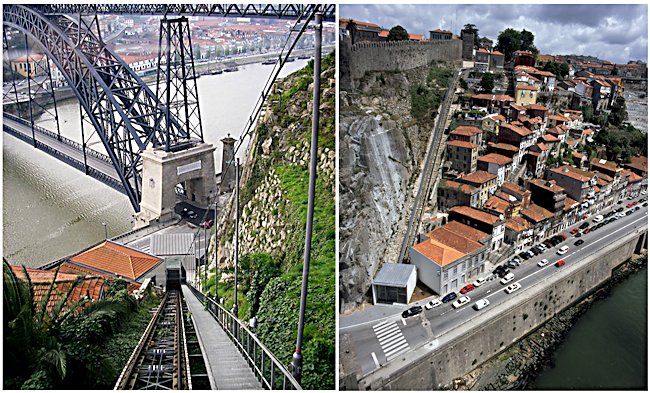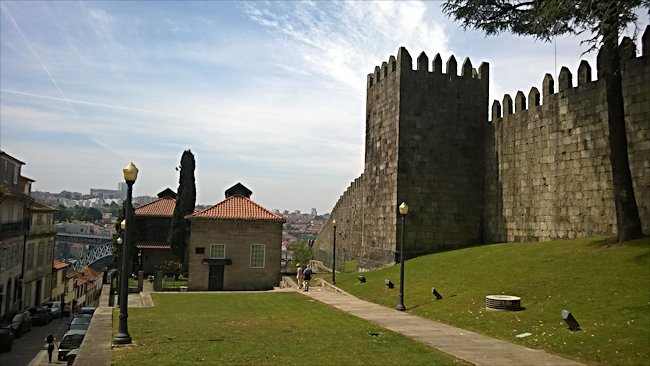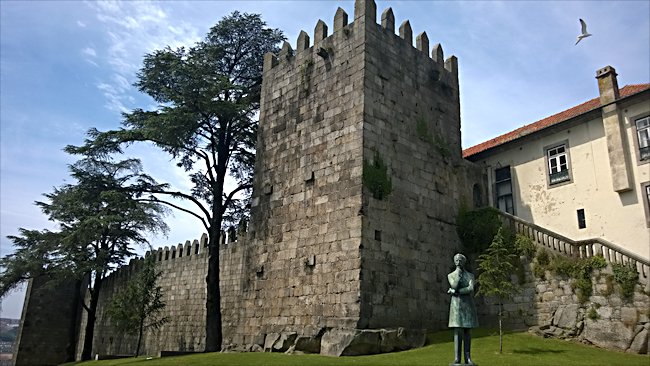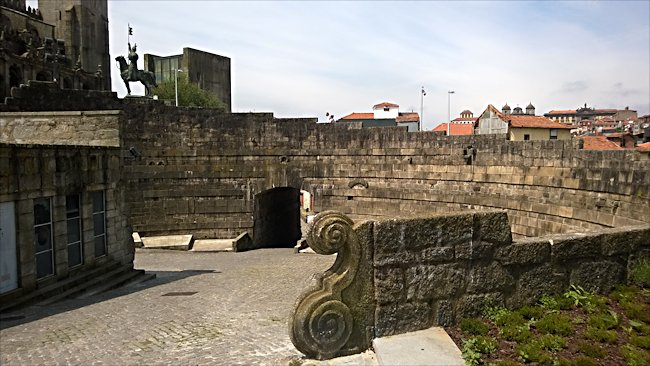Porto's Funicular Railway & City Walls
It is a very long steep walk up the hillside and the river front to the top of the hill. If you are a Northern European used to colder weather conditions you might find your shirt soaking wet with sweat after the exertion it requires to get up to the top on a typical Porto summers day.

You can use the Funicular Dos Guindais Railway to get up to Porto's Cathedral
If you have a problem breathing or a medical condition like asthma or COPD do not attempt to climb up the hill. Take a taxi. Your other option is to walk to the northern entrance of the King Luis I bridge and take the funicular railway up to the top of the hill. The funicular railway of Porto is called Funicular dos Guindais. The ground-level riverside railway station is called Riberira and is found on the road Rua Gustavo Eiffel. The station at the top of the hill is called Batatha and is on the road Rua de Augusto Rosa. The Batatha entrance looks like the stairs down to a New York subway station. It is on the other side of the road opposite the last square fortress tower on the mediaeval city wall.
Between November and April it is open at 8 AM in the morning and stops running at 8 PM. Between May and July plus September to October it is open from 8 AM to 10 PM. In August it is open an extra 2 hours until midnight, running from 8 AM. There is no discount for Porto cardholders. The Andante travel card is not accepted even though many websites, posters and travel guide books say that it is. In 2015 the cost was 2 Euros for a one-way ticket. If there is a group of you it might be cheaper to take a taxi.
The station building at the bottom of the hill looks modern and is fronted with glass. Confusingly this is not where you buy your ticket. The tiled terraced building next door is in fact the funicular railway station ticket office.
The funicular railway has been renovated and looks modern but it was built on top of an original line that was constructed in 1891. The old line was closed soon after opening because of a serious accident. The funicular railway you see today was reopened 19 February 2004. Try to be the first on the carriage and sit facing the river. You will be rewarded with a panoramic view of the wrought iron Dom Luis I bridge, the river Douro and the port wine warehouses on the south side of the river.
Locals also use the Funicular dos Guindais to get up to the top of the hill and connect with Porto's Metro system. The ride is only 3 minutes long and goes through a tunnel at the top. If you are using the funicular to go down the hill to not sit at the front if you are scared of heights. It is a little bit like a funfair ride, as you come out of the tunnel and go over the crest of the hill. You feel like you are on a very slow rollercoaster. Rather cleverly there is a levelling system built into each carriage so unlike a rollercoaster you do not feel like you are hurtling towards the ground.

This is the view that greats you when you get out of the Funicular Railway at the top of the valley side. The entrance is behind you.
Porto's Old City Walls
In mediaeval times the city of Porto used to be surrounded by high stone built castle-like city walls. The best preserved section runs along the line taken by the funicular railway. You can get an idea of how robust they were. They went down to and along the Riberira Riverfront. Behind the crenulations there is a walkway whether city guards used to patrol. Unfortunate at present this is not open to the public.
This section of the wall has been rebuilt to its original condition. It enables you to get a better understanding of how the city looked rather than leaving it as a crumbling ruin like you find at so many British fortifications and castles.

This is the best preserved section of the old Porto City wall. The funicular railway entrance is on the other side of the road from this tower.
You can tell the age of a mediaeval fortification by looking at the design of the towers. Porto city wall towers are square. They were therefore built before the age of gunpowder and siege cannons. They are very early in design. Later towers were circular so as to give the defenders a better chance of having a cannonball deflect rather than embed itself in the stonework.
When you are on the south bank of the river Douro, if you look hard, you can see the crumbling remains of the western city walls. There are no crenulations visible just the remains of a very thick wall running up the side of the hill on the western side of the Riberira quayside river frontage.
If you walk west along the Rua Saraiva de Carvalho road from the Batalha upper funicular railway station towards the cathedral you will come across the remains of another city wall tower, at the junction with the Avenue Vimara Peres. On the other side of the road there is a sunken semicircular depression surrounded by a stone wall. This is the preserved ancient mediaeval Gateway into the city.

This is the only remaining old city wall defended gate. It is near the Cathedral.
Travel Books

